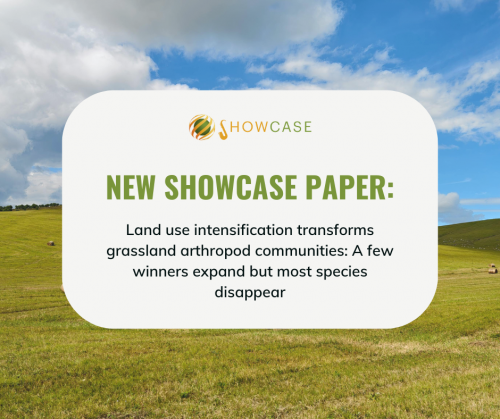A new SHOWCASE paper, written by project partner Wageningen University, investigates how land-use intensity shapes arthropod communities in Dutch grasslands. Arthropods, which are vital for pollination, nutrient cycling and overall ecosystem health, have declined dramatically in recent decades, largely due to agricultural intensification and habitat loss. By studying grasslands ranging from low-input hay meadows to highly fertilized silage fields, project researchers explored how species richness, abundance and community composition respond to increasing management intensity. Their findings suggest that focusing on individual species’ responses, rather than broad measures like total abundance or species richness, provides a clearer understanding of biodiversity change. Understanding which arthropods thrive or decline under intensification offers crucial insights into how to sustain biodiversity in Europe’s farmed landscapes.
The study took place in the Geul valley in the south of the Netherlands — a biodiversity-rich region where grasslands are found on clay and loess soils. Researchers selected 41 grassland sites spanning the full spectrum of management intensity, from unfertilized semi-natural meadows to highly productive, fertilized dairy pastures. Using sweep-net sampling and pollinator walks, they collected arthropods across a 150-metre transect at each site, and counted all flies, wasps, bugs and cicadas, beetles, grasshoppers and spiders. Key groups in each of these orders were identified to species. Data on species abundance and richness were then linked to land-use intensity, measured as annual energy yield for livestock. Advanced statistical models were used to assess how intensification affects arthropod diversity, community composition and the balance between species that “win” or “lose” under intensified management. Together, these methods provided a detailed picture of how modern farming practices reshape the diversity and structure of grassland arthropod communities.
Striking patterns were revealed in how grassland arthropods respond to land use intensification. From nearly 170,000 specimens, researchers found that total arthropod abundance remained stable because flies (Diptera) became more abundant in intensive systems, offsetting declines in other groups. In contrast, species richness declined as productivity increased, particularly among true bugs. Species composition also varied greatly between sites regardless of productivity level, indicating that community turnover rather than simple species loss drives many differences. Consequently, accounting for species identity revealed a larger biodiversity loss than simply comparing richness. Over half of all species were concentrated in low-productivity grasslands, meaning they are already losing under low-to-medium intensification levels. Up to 85% of all species lost under strong intensification, while only 9% thrived in high-intensity fields. These “winning” species were almost always found across a wide productivity range, whereas most losing species were restricted to low-intensity meadows.
Overall, the SHOWCASE study found that intensive grassland management leads to a dramatic loss of arthropod species, with most species disappearing completely. Surprisingly, total arthropod numbers remained roughly stable. This is probably because a few ‘winner’ species, that benefit from high productivity levels, became more abundant. This indicates that intensification favors a small subset of adaptable species while most others are lost. The paper, which was also featured in the popular platform Nature Today, highlights that standard biodiversity metrics can mask these changes, as overall abundance and richness may appear stable even when species diversity collapses. The biggest biodiversity loss occurred already at low-to-medium intensification levels. Therefore, conserving low-intensity, species-rich grasslands is therefore crucial to maintain arthropod diversity and the ecosystem functions they support.
Read the full paper here.
